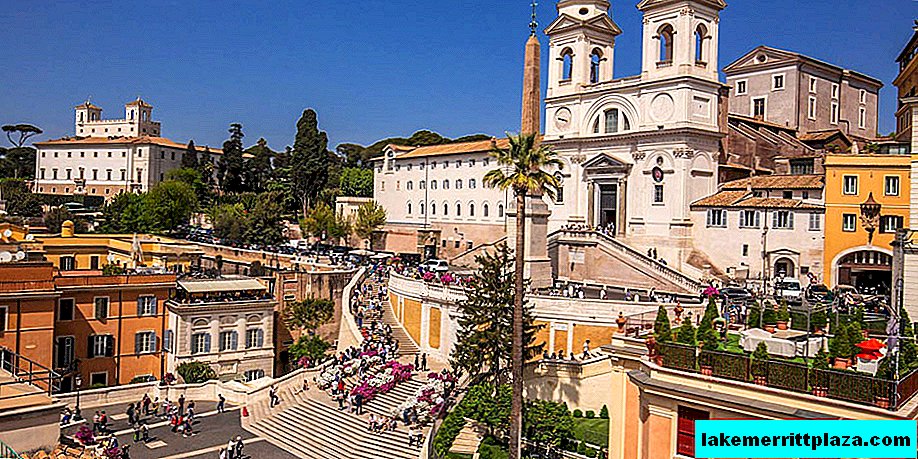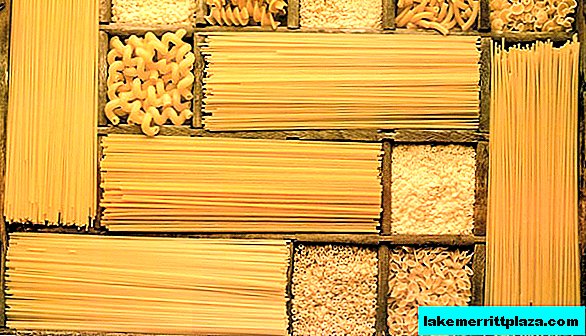Milan somewhat remotely resembles Moscow: the same radial-ring principle of urban planning, according to which roads diverge in different directions from the center, simultaneously crossing the rings of the former fortress walls. In the center of the city is the Most Main Square with the Most Main Building. In Milan, this is the Duomo Cathedral, located on the square of the same name. By the way, this city also has its own “Kremlin” - Sforza Castle, in the image of which Moscow was built. In one of the castle museums, some of the Duomo treasures are also stored.
Among all the attractions of the city, the cathedral has a special place. The point here is not only in its popularity among tourists (annually up to 700,000 people rise only on its terraces).
Duomo Cathedral in Milan - This is a unique building, which has no analogues. Firstly, this is the only Catholic church built of white marble. Secondly - the only Italian cathedral, originally built in the style of flaming Gothic. Thirdly, it is the fifth largest temple in the world, capable of accommodating up to 40,000 people.
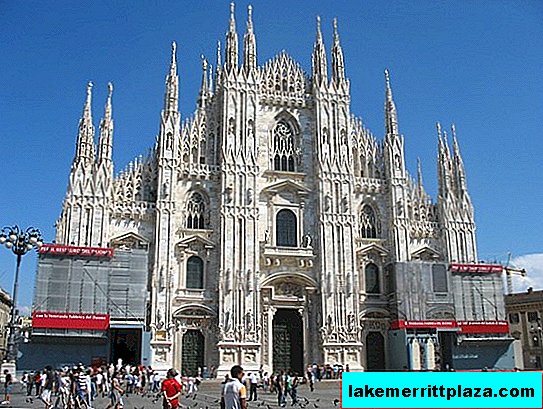
Duomo Cathedral in Milan can accommodate up to 40,000 people
Helpful advice: In this article you will learn the most important things to visit in the Duomo. But if your interests in Milan are not limited to the cathedral, download our audio guide in the city center for the iPhone link to go the entire route from 60 main attractions.
The audio guide works even without the Internet, and a built-in map with GPS will help you easily navigate the city. In the trial free version, the first 5 points are available to try, and the full version will cost you only 5 Euros. It is much cheaper than even the most budget excursions.
Duomo Cathedral in Milan: Middle Ages and Renaissance
There has always been a square in the center of Milan, and there has always been a temple in this square. The Celts, who founded the settlement at the spurs of the Alps in the VII century. BC, set up a sanctuary here. The Romans, who gave this settlement its name - Mediolanum - erected the temple of Minerva.
In the 4th century on the ruins of this temple the church of St. Thekla (Thekla) arose. After 2 centuries, the church was destroyed by the Lombards, and was rebuilt again in the 7th century. as the Basilica of the Virgin - Santa Maria Maggiore.
In the XIV century. almost all of Italy was exhausted by incessant wars and epidemics. But in order to show the external and internal enemies that Milan is still one of the strongest and richest cities in Europe, the Duke Giangaleazzo Visconti (1351-1402) ordered the construction of a cathedral of unprecedented beauty, size and ... value on the main square.
Since at that time secular rulers were not authorized to issue such orders in relation to land belonging to the Catholic Church, the order was signed by Bishop Antonio Saluzzo.

In the center of Milan there was always a square on which the temple always stood
The church of Santa Maria Maggiore was demolished, and on May 23, 1386, the construction of the cathedral dedicated to the Nativity of the Virgin began on the main square of the city.
But an unprecedented matter: not recognized Italian architects, but German and French masters were involved in the creation of the project. This has never happened in history. After all, Italians have always been quite skeptical of "barbaric" Gothic, despite the fact that its first samples appeared on Sicily thanks to the Normans back in the 11th century. However, already in 1387 the Italian engineer Simone da Orsenigo was appointed the chief engineer.
It was originally planned that the temple would be erected from bricks of special firing; the remains of masonry dating to the end of the fourteenth century have survived to this day. But soon the duke ordered the use of Kantolian marble from his own quarry near Lago Maggiore for the construction.
To facilitate the delivery of marble from the quarry to the construction site in Milan, deep channels were dug. For the material, the duke did not take a penny from the Holy See, but soon the construction was stopped anyway due to the lack of necessary funds from the church.
The spiritual authorities, despite all their influence, did not find the opportunity to continue the construction of the temple. Duomo Cathedral in Milan I had to pass on to secular rulers who were able to quickly collect the corresponding tribute from wealthy citizens. Construction was resumed.
In 1417, the first consecration of the cathedral, or rather, its main altar, took place. Around the same years, the oldest stained glass windows created in Tirol are also dated.
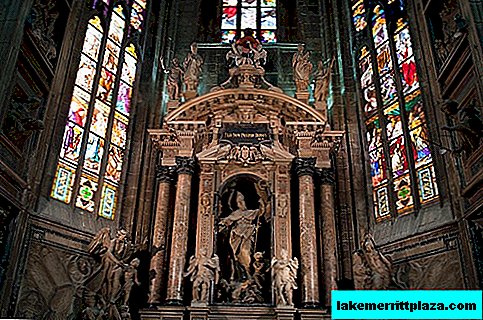
Duomo Cathedral is decorated with 45 huge stained glass panels
For almost a century, the project of the cathedral was alternately either Germans or Italians, until in 1470 Gianiforte Solari was appointed the chief architect, gravitating to Renaissance forms. In parallel, he led the construction of the church of Santa Maria delle Grazie. In 1492, the construction of this church was undertaken by Donato Bramante, who invited Leonardo for her painting.
It was Bramante and Leonardo, who was always interested in everything, and not just the Last Supper, on which he worked then, that Solari proposed to modernize the project.
So the Duomo Cathedral in Milan acquired an unusual octagonal dome. In 1572, the main construction was completed, after which the cathedral was solemnly consecrated by Cardinal Saint Carlo Borromeo (1538-1584), buried, by the way, in one of the crypts of the cathedral.
Duomo Cathedral in Milan: from the New Time to the present
The Duomo Cathedral in Milan acquired a modern look much later: in the XVIII-XIX centuries. In 1769, it was decorated with a spire 104 m high with a gilded statue of the Virgin, 4.16 m high and weighing almost a ton. The townspeople immediately called her in their own way - Madonnina ("Madonna"), and the Spanish Habsburgs, who ruled Milan in those years, immediately rushed to issue a decree according to which not a single building in the city should be higher than the spire of the cathedral.
Soon, the Duomo Cathedral in Milan acquired another curiosity. A metal tape along the entrance is nothing but an astronomical clock of the late 18th century. By the way, the columns of the temple are also a kind of “calendar”: there are a total of 52, according to the number of weeks in a year.

In 1769, the Cathedral was decorated with a hundred-meter spire with a gilded statue of the Virgin
The fancifully openwork facade of the cathedral, which immediately attracts attention, is worth seeing Duomo square in Milan, appeared thanks to Napoleon.
Napoleon, who by that time wished to become king of Italy, decided that the solemn coronation ceremony would take place in this cathedral. As happened in 1805, however, the famous "stone forest" in the Neo-Gothic style (135 spiers) was completed only by 1813. Architect Carlo Amati supervised the construction of the new facade.
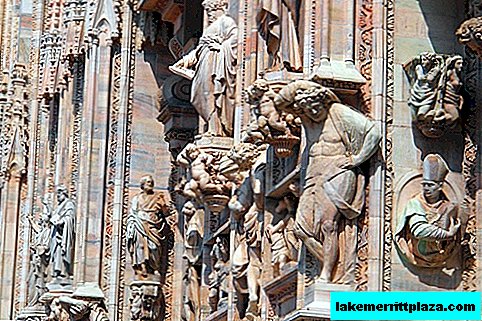
On the external walls and spiers of the Duomo, there are 2,300 statues
The decoration of the cathedral continued until the 60s. last century. In the creation of stained-glass windows and sculptures during the XV-XX centuries. almost all famous Italian masters took part. Currently, there are 2,300 statues on its outer walls and spiers, and 1,100 more in the interior.
The Duomo on sunny days, which are not uncommon in this city, is also a real "kaleidoscope": 45 huge stained glass panels adorn its walls and architectural elements.
Opening hours and tickets
The famous German romantic poet Heine believed that inspect Duomo square in Milan and the cathedral is best on a clear moonlit night. It is on such a night that the white marble building looks truly beautiful.
To check whether this is true or not is impossible in our time: the Duomo Cathedral in Milan, like thousands of other attractions around the world, is illuminated from all sides in the dark. The sight, however, is amazing. However, the cathedral is closed at night, and walking around the city at this time alone is better not worth it.

Each winter, the cathedral exhibits quadrons of St. Carlo Borromeo
The cathedral also does not work during Christmas, January 1 and May 1. On other days, access to the Duomo is possible from 8:00 to 19:00. Ticket price for adults is 3 Euros, for children from 6 to 12 years old - 2 Euros and up to 6 years old - free of charge.
With a ticket to the Duomo, you can also see the Duomo Museum and the Church of San Gottardo.
There is a variety of tickets, which also include the Duomo Archaeological Zone, but they cost more - 7 Euros. For visitors under 26 years of age, a discount on these tickets is provided - they will cost 3 Euros.
Milan Cathedral Terrace Tickets
Another popular attraction in the Cathedral is to get on its terraces. The cost of a walk through the "stone forest" depends on whether you decide to climb the roof by a spiral marble staircase (€ 9) or by elevator (€ 13). For children from 6 to 12 years old a discount is provided - for them tickets will cost 4.5 and 7 Euros, respectively.
Terraces are open daily from 9:00 to 19:00, but the ticket office is open until 18:00, and the last visitors are allowed at 18:10.
Duomo pass
You can combine a visit to the Cathedral and the Terrace using the Duomo Pass. It combines the possibilities of an extended ticket to the Duomo (with the possibility of access to the Archaeological Zone), as well as a visit to the Terrace with an elevator lift.
The main convenience of Duomo Pass is the ability to avoid queues on the spot, which periodically can be quite long. In addition, Duomo Pass is released without reference to the date and specific time of the visit. That is, you can use it on any day convenient for yourself until the end of the year.
You can learn more about Duomo Pass and purchase it online on this page.
How to get to the Duomo and noteworthy events
The easiest way to get to the Cathedral of Milan is to use the metro (yellow line 3) from Milano Centrale (railway station). The cathedral is located in the very center of the city, and the station you need is called Duomo.
If you are in Milan for just a few days, then it may be more convenient to find a hotel in the immediate vicinity of the Duomo. The largest selection of such hotels can be found on this page.
If your trip is planned in the first half of September, it is possible that you can attend the ceremony in honor of the Sacred Nail from the cross of Jesus, which is stored on all other days in one of the niches under the roof of the temple.
In order to show the parishioners the Holy Nail, the archbishop of Milan himself rises to a height of 42 m after a special lift-device in the form of a cloud (according to legend created by Leonardo).

Cathedral Terrace offers one of the best views of Milan
Every year in November-December, the so-called quadronies of St. Carlo Borromeo (memory day - November 4) are exhibited in the cathedral - a series of 54 canvases created by Italian painters of the XVII-XVIII centuries.
On the same days Duomo square becomes the venue for the largest Christmas market, and sales begin at the Victor Emmanuel II Gallery. If you go through this gallery through, you can go to another square - La Scala, where the most famous opera house in the world is located.
Other popular articles
- The Last Supper of Leonardo da Vinci: must not be missed in Milan
- Metro Milan: map, tickets, opening hours
- What to see in Milan: 10 ideas how to spend time
- How to get from Malpensa Airport to the center of Milan
- How to get from Milan to Venice and from Venice to Milan
Photos by: Megan Eaves, juan carlos peaguda, John Picken Photography, Patrick Shyu, Simon & Vicki, magro_kr.



